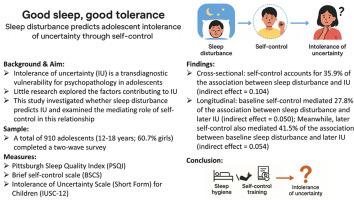良好的睡眠,良好的耐受性:睡眠障碍预示着青少年通过自我控制对不确定性的耐受性
IF 3.4
2区 医学
Q1 CLINICAL NEUROLOGY
引用次数: 0
摘要
不确定性耐受性(IU)最近被确定为青少年各种形式精神病理的一种跨诊断易感性。然而,很少有研究探讨导致IU的因素,限制了有效的早期干预和预防策略的发展。本研究探讨了睡眠障碍是否预测IU,并检验了自我控制在这一关系中的中介作用。方法共910名青少年(平均年龄14.63岁,SD = 1.41,范围12-18岁,60.7%为女孩)完成了两波睡眠障碍、自我控制和IU的调查。通过横断面和纵向的中介分析来检验睡眠障碍对IU的预测作用以及通过自我控制的间接影响。结果睡眠障碍对IU有显著的预测作用,而自我控制在其中起中介作用。在横断面中介模型中,自我控制占睡眠障碍与IU之间关联的35.9%(间接效应= 0.104,SE = 0.017, 95% CI[0.072, 0.138])。在纵向中介模型中,基线自我控制介导了27.8%的睡眠障碍与后期IU之间的关联(间接效应= 0.050,SE = 0.013, 95% CI [0.025, 0.077]);同时,后期自我控制也介导了基线睡眠障碍与后期IU之间41.5%的关联(间接效应= 0.054,SE = 0.013, 95% CI[0.030, 0.081])。结论初步提示睡眠障碍是青少年IU发生的危险因素,自我控制是其重要的潜在机制。旨在改善睡眠卫生和增强自我控制的干预措施可能有助于减少IU并支持青春期的心理健康。本文章由计算机程序翻译,如有差异,请以英文原文为准。

Good sleep, good tolerance: Sleep disturbance predicts adolescent intolerance of uncertainty through self-control
Background
Intolerance of uncertainty (IU) has recently been identified as a transdiagnostic vulnerability for various forms of psychopathology in adolescents. However, little research has explored the factors contributing to IU, limiting the development of effective early intervention and prevention strategies. This study investigated whether sleep disturbance predicts IU and examined the mediating role of self-control in this relationship.
Methods
A total of 910 adolescents (Mean age = 14.63 years, SD = 1.41, range = 12–18; 60.7 % girls) completed a two-wave survey assessing sleep disturbance, self-control, and IU. Cross-sectional and longitudinal mediation analyses were conducted to test the predictive role of sleep disturbance on IU and the indirect effect through self-control.
Results
Sleep disturbance significantly predicted IU concurrently and prospectively, with self-control mediating these relationships. In the cross-sectional mediation model, self-control accounts for 35.9 % of the association between sleep disturbance and IU (indirect effect = 0.104, SE = 0.017, 95 % CI [0.072, 0.138]). In the longitudinal mediation models, baseline self-control mediated 27.8 % of the association between sleep disturbance and later IU (indirect effect = 0.050, SE = 0.013, 95 % CI [0.025, 0.077]); Meanwhile, later self-control also mediated 41.5 % of the association between baseline sleep disturbance and later IU (indirect effect = 0.054, SE = 0.013, 95 % CI [0.030, 0.081]).
Conclusions
These findings preliminarily suggested sleep disturbance as a risk factor for adolescent IU and identified self-control as a key underlying mechanism. Interventions aimed at improving sleep hygiene and enhancing self-control may help reduce IU and support mental health during adolescence.
求助全文
通过发布文献求助,成功后即可免费获取论文全文。
去求助
来源期刊

Sleep medicine
医学-临床神经学
CiteScore
8.40
自引率
6.20%
发文量
1060
审稿时长
49 days
期刊介绍:
Sleep Medicine aims to be a journal no one involved in clinical sleep medicine can do without.
A journal primarily focussing on the human aspects of sleep, integrating the various disciplines that are involved in sleep medicine: neurology, clinical neurophysiology, internal medicine (particularly pulmonology and cardiology), psychology, psychiatry, sleep technology, pediatrics, neurosurgery, otorhinolaryngology, and dentistry.
The journal publishes the following types of articles: Reviews (also intended as a way to bridge the gap between basic sleep research and clinical relevance); Original Research Articles; Full-length articles; Brief communications; Controversies; Case reports; Letters to the Editor; Journal search and commentaries; Book reviews; Meeting announcements; Listing of relevant organisations plus web sites.
 求助内容:
求助内容: 应助结果提醒方式:
应助结果提醒方式:


